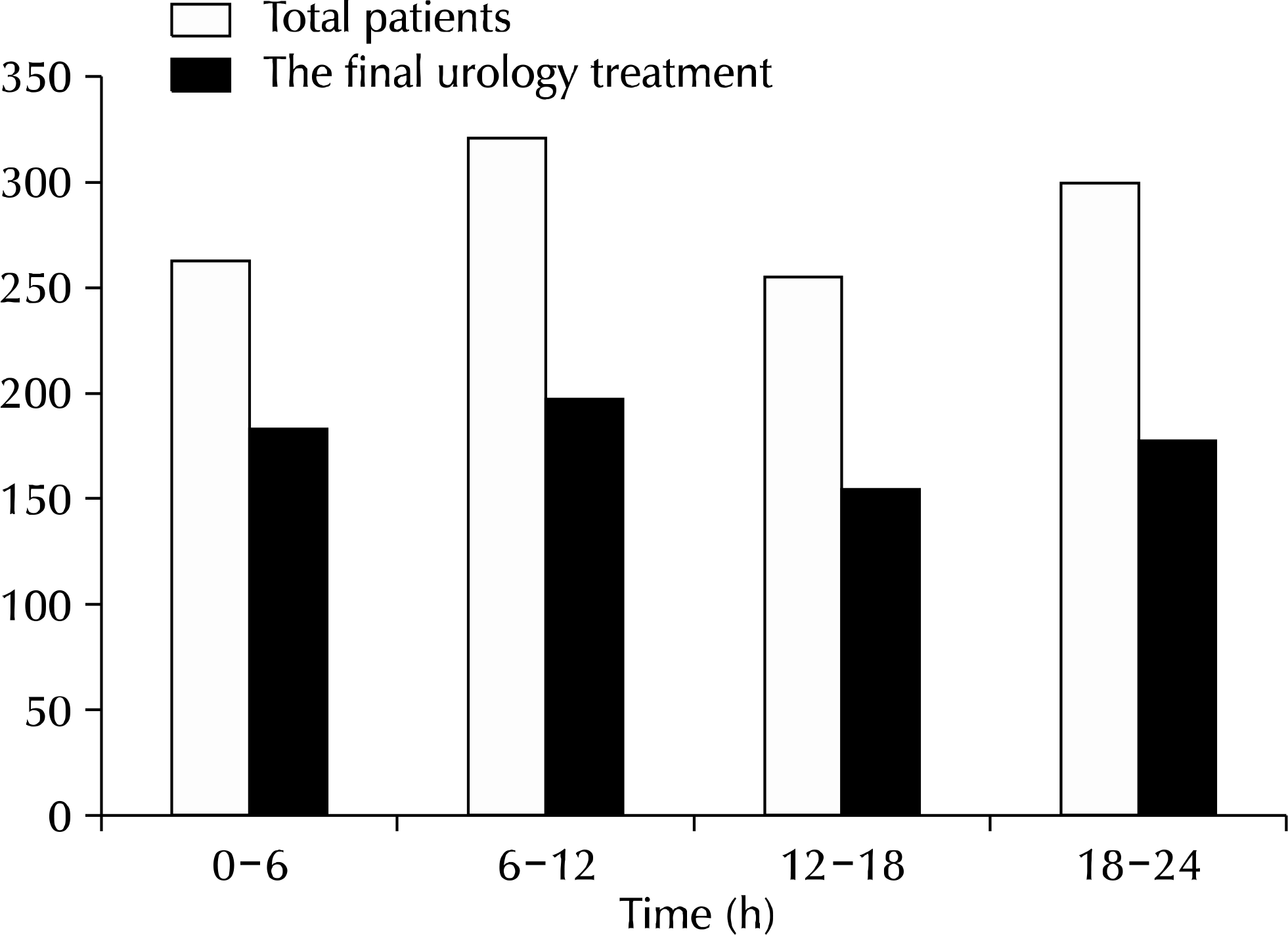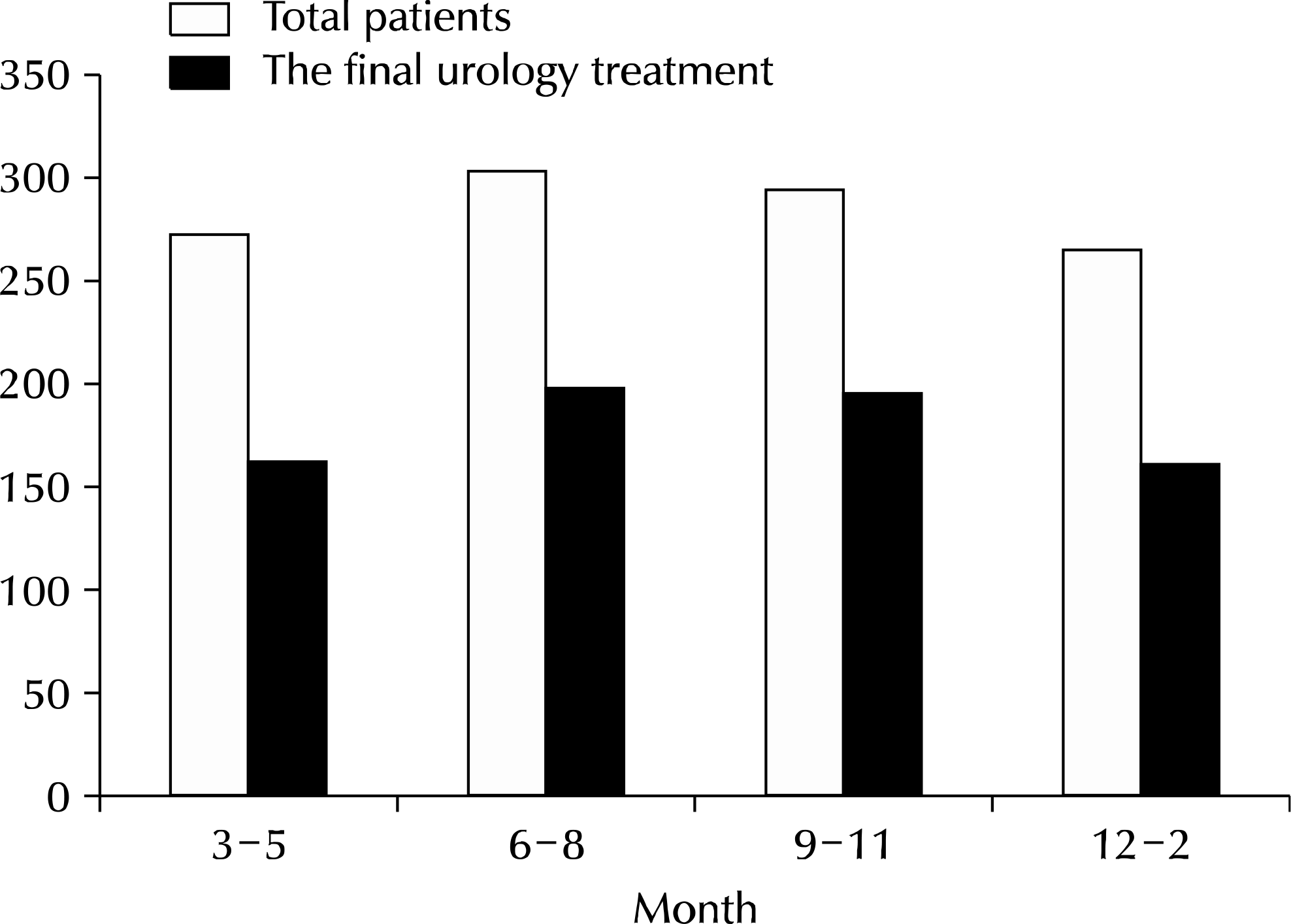Abstract
Purpose:
Acute abdominal pain accounts for 7-10% of all emergency department visits. The purpose of this study is to investigate the epidemiology and outcome of acute flank pain at regional emergency medical centers (EMC) and to investigate the necessity of urologists.
Materials and Methods:
We retrospectively reviewed all records of EMC visits for flank pain between 1 July 2015 and 30 June 2017. The renal colic was defined according to the code allocation of the Korean standard classification of disease-6 code N132, N200-N203, and N210-N211. The results of this study were retrospectively analyzed and the characteristics of the patients.
Results:
The total number of visits to the EMC was 67,792, and the number of visits for acute abdominal pain was 9,641. The number of visits for acute flank pain was 1,133 and the number of patients was 1,018. The departments included emergency medicine (n=235), urology (n=711), internal medicine (n=132), general surgery (n=19), gynecology (n=10), and others (n=26). The causes of urological flank pain were urolithiasis in 628 cases, infection in 41 cases, and other diseases in 42 cases. Among these, 244 cases were admitted, and 193 cases of them were urolithiasis patients, and 171 patients underwent stone removal surgery.
REFERENCES
1.Gans SL., Pols MA., Stoker J., Boermeester MA. expert steering group. Guideline for the diagnostic pathway in patients with acute abdominal pain. Dig Surg. 2015. 32:23–31.

2.Hastings RS., Powers RD. Abdominal pain in the ED: a 35 year retrospective. Am J Emerg Med. 2011. 29:711–6.

3.Selbst SM., Friedman MJ., Singh SB. Epidemiology and etiology of malpractice lawsuits involving children in US emergency departments and urgent care centers. Pediatr Emerg Care. 2005. 21:165–9.
4.Kachalia A., Gandhi TK., Puopolo AL., Yoon C., Thomas EJ., Griffey R, et al. Missed and delayed diagnoses in the emergency department: a study of closed malpractice claims from 4 liability insurers. Ann Emerg Med. 2007. 49:196–205.

5.Patterson BW., Venkatesh AK., AlKhawam L., Pang PS. Abdominal computed tomography utilization and 30-day revisitation in emergency department patients presenting with abdominal pain. Acad Emerg Med. 2015. 22:803–10.

6.Medford-Davis L., Park E., Shlamovitz G., Suliburk J., Meyer AN., Singh H. Diagnostic errors related to acute abdominal pain in the emergency department. Emerg Med J. 2016. 33:253–9.

7.Preminger GM., Tiselius HG., Assimos DG., Alken P., Buck C., Gallucci M, et al. 2007 guideline for the management of ureteral calculi. J Urol. 2007. 178:2418–34.

8.Wilkinson H. Clinical investigation and management of patients with renal stones. Ann Clin Biochem. 2001. 38:180–7.

9.Lee HN., Yoon HN., Shim BS. The trend change of incidence and treatment of urolithiasis between the 1980s and 2000s. Korean J Urol. 2007. 48:40–4.

10.Liu W., Esler SJ., Kenny BJ., Goh RH., Rainbow AJ., Stevenson GW. Low-dose nonenhanced helical CT of renal colic: assessment of ureteric stone detection and measurement of effective dose equivalent. Radiology. 2000. 215:51–4.

11.Graham A., Luber S., Wolfson AB. Urolithiasis in the emergency department. Emerg Med Clin North Am. 2011. 29:519–38.
12.Hong DY., Kim JW., Lee KR., Park SO., Baek KJ. Epidemiologic and clinical characteristics of patients presenting with renal colic in Korea. Urol J. 2015. 12:2148–53.
13.Paolillo C., Spallino I., Cervellin G., Catena F. Is there still a role for abdominal plain X-ray in acute abdomen? Emerg Care J. 2015. 11:50–1.

14.Laméris W., van Randen A., van Es HW., van Heesewijk JP., van Ramshorst B., Bouma WH, et al. Imaging strategies for detection of urgent conditions in patients with acute abdominal pain: diagnostic accuracy study. BMJ. 2009. 338:b2431.

15.Caporale N., Morselli-Labate AM., Nardi E., Cogliandro R., Cavazza M., Stanghellini V. Acute abdominal pain in the emergency department of a university hospital in Italy. United European Gastroenterol J. 2016. 4:297–304.

17.Cervellin G., Lippi G. Abdominal migraine in the differential diagnosis of acute abdominal pain. Am J Emerg Med. 2015. 33:864. .e3-5.

18.Tayal VS., Bullard M., Swanson DR., Schulz CJ., Bacalis KN., Bliss SA, et al. ED endovaginal pelvic ultrasound in nonpregnant women with right lower quadrant pain. Am J Emerg Med. 2008. 26:81–5.

19.Cervellin G., Comelli I., Sartori E., Lippi G. A four-year survey on unexpected pregnancy diagnoses in a large urban emergency department in Parma, Italy. Int J Gynaecol Obstet. 2014. 127:51–4.

20.Chen YK., Lin HC., Chen CS., Yeh SD. Seasonal variations in urinary calculi attacks and their association with climate: a population based study. J Urol. 2008. 179:564–9.

21.Cupisti A., Pasquali E., Lusso S., Carlino F., Orsitto E., Melandri R. Renal colic in Pisa emergency department: epidemiology, diagnostics and treatment patterns. Intern Emerg Med. 2008. 3:241–4.

22.Manfredini R., Gallerani M., Cecilia Ol., Boari B., Fersini C., Portaluppi F. Circadian pattern in occurrence of renal colic in an emergency department: analysis of patients' notes. BMJ. 2002. 324:767.

23.Boari B., Manfredini R. Circadian rhythm and renal colic. Recenti Prog Med. 2003. 94:191–3.
24.Robert M., Roux JO., Bourelly F., Boularan AM., Guiter J., Monnier L. Circadian variations in the risk of urinary calcium oxalate stone formation. Br J Urol. 1994. 74:294–7.
25.Laerum E. Urolithiasis in general practice. An epidemiological study from a Norwegian district. Scand J Urol Nephrol. 1983. 17:313–9.
26.Cervellin G., Comelli I., Comelli D., Cortellini P., Lippi G., Meschi T, et al. Regional short-term climate variations influence on the number of visits for renal colic in a large urban Emergency Department: results of a 7-year survey. Intern Emerg Med. 2011. 6:141–7.

Table 1.
Number and rate of patients admitted with renal colic
Table 2.
Care trends of patients with acute flank pain in the emergency room
Table 3.
Care trend of urology patients in the emergency room




 PDF
PDF ePub
ePub Citation
Citation Print
Print




 XML Download
XML Download